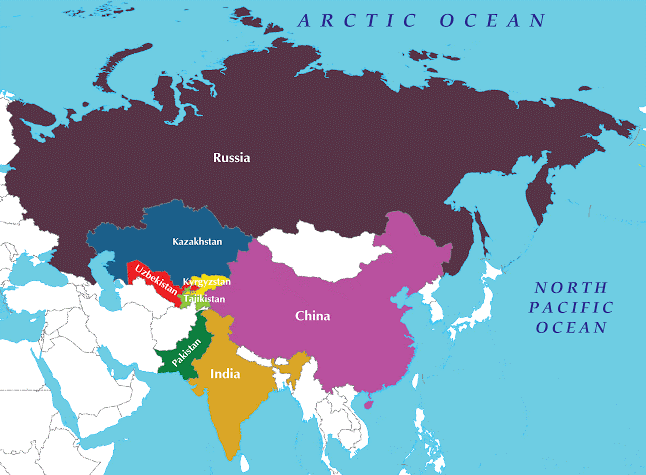CONTENTS
- SCO Film Festival
- All India Survey on Higher Education (AISHE) 2020-2021
SCO Film Festival
Focus: GS II: International Relations
Why in News?
Recently, the five-day Shanghai Cooperation Organization’s Film Festival opened in Mumbai.
About SCO Film Festival
- Organized by: The National Film Development Corporation (NFDC), a Public Sector Undertaking of the Ministry of Information and Broadcasting, in partnership with the SCO Council of Heads of States.
- Objective: The festival aims to foster cinematic partnerships, facilitate program exchanges, support emerging filmmaking talent, and bridge the cultural gap between the Shanghai Cooperation member countries.
- Film Showcase: The festival intends to showcase selected films from Member States, Observer States, and Dialogue partner States.
About Shanghai Cooperation Organization

- Founded in June 2001, it was built on the ‘Shanghai Five’, the grouping which consisted of Russia, China, Kazakhstan, Kyrgyzstan and Tajikistan.
- They came together in the post-Soviet era in 1996, in order to work on regional security, reduction of border troops and terrorism.
- They endowed particular focus on ‘conflict resolution’, given its early success between China and Russia, and then within the Central Asian Republics.
- Some of their prominent outcomes in this arena entail an ‘Agreement on Confidence-Building in the Military Field Along the Border Areas’ (in 1996) between China, Russia, Kazakhstan, Kyrgyzstan and Tajikistan, which led to an agreement on the mutual reduction of military forces on their common borders in 1997.
- It would also pitch in to help the Central Asian countries resolve some of their boundary disputes.
- In 2001, the ‘Shanghai Five’ inducted Uzbekistan into its fold and named it the SCO, outlining its principles in a charter that promoted what was called the “Shanghai spirit” of cooperation.
- The precise assertion, combined with some of the member states’ profiles, of building a “new international political and economic order” has often led to it being placed as a counter to treaties and groupings of the West, particularly North Atlantic Treaty Organisation (NATO).
Member states
- India, Kazakhstan, China, Kyrgyzstan, Pakistan, Russia, Tajikistan and Uzbekistan.
- The SCO also has four observer states — Afghanistan, Iran, Belarus and Mongolia — of which Iran and Belarus are now moving towards full membership.
Main goals
- Strengthening mutual trust and neighbourliness among the member states;
- Promoting their effective cooperation in politics, trade, economy, research and technology, and culture.
Focus areas:
- Education, energy, transport, tourism and environmental protection.
- It also calls for joint efforts to maintain and ensure peace, security and stability in the region; and the establishment of a democratic, fair and rational new international political and economic order.
Organizational structure of SCO
The SCO secretariat has two permanent bodies —
- SCO Secretariat based in Beijing
- Executive Committee of the Regional Anti-Terrorist Structure (RATS) based in Tashkent.
Other than this, the grouping consists of
Heads of State Council (HSC):
- It is the supreme decision-making body of the organisation.
- It meets annually to adopt decisions and guidelines on all important matters relevant to the organisation.
Heads of Government Council (HGC):
- The HGC (mainly including Prime Ministers) also meets annually to zero in on the organisation’s priority areas and multilateral cooperation strategy.
- It also endeavours to resolve present economic and cooperation issues alongside approving the organisation’s annual budget.
Foreign Ministers Council:
- The Foreign Ministers Council considers issues pertaining to the day-to-day activities of the organisation, charting HSC meetings and consultations on international problems within the organisation and if required, makes statements on behalf of the SCO.
All India Survey on Higher Education (AISHE) 2020-2021
Focus: GS II: Education
Why in News?
Ministry of Education recently released All India Survey on Higher Education (AISHE) 2020-2021
All India Survey on Higher Education (AISHE) Overview
- Conducted by: Ministry of Education
- Start Year: 2011
- Coverage: All higher educational institutions in India imparting higher education.
- Objectives:
- To identify and include all institutions of higher learning in India.
- To collect data from higher education institutions on various aspects of higher education.
- Data Collected: Detailed information on various parameters such as student enrollment, teacher data, infrastructure, and financial information.
Highlights of AISHE 2020-2021:
- First time filled data online using Web Data Capture Format developed by Department of Higher Education through the National Informatics Centre (NIC).
- Total number of Universities: 1,113
- Total number of Colleges: 43,796
- Number of Universities has increased by 70, number of Colleges has increased by 1,453, in 2020-21 over 2019-20.
- Total number of Standalone Institutions: 11,296
- Total enrollment in higher education: 4.14 crore, up 7.5% from 2019-20
- Female enrollment: 2 crore, up 13 lakh from 2019-20
- Gross Enrolment Ratio improved for all social groups
- Enrollment in Distance Education up 7% from 2019-20
- Gender Parity Index increased from 1 to 1.05 from 2017-18 to 2020-21
- Total number of faculty/teachers increased by 47,914 from 2019-20





